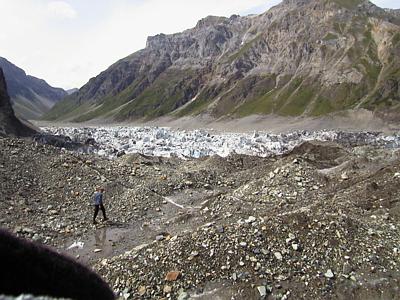18 July, 1999
July 18
I heard some loud rumbling from the vicinity of the lake at about 5:00 AM
this morning. It sounded like some major calving and collapse of ice was
occurring. When I checked the seismograph later in the day the seismic
record confirmed what I had heard from my tent. The seismograph drum was
literally black with inky wave patterns for a few hours which corresponded
to the early morning. Most of the settling of the ice dam had occurred
during the night.
Don Lindsay (grad student) and I went out to the former drill site to
download pressure transducer data from the data logger at the borehole.
When first drilled, the hole had a water level of 22 meters. This means
that water came into the drill hole up to a point 22 meters below the
surface of the ice. Today the 147-meter deep hole was empty. Fresh
fractures ran throughout the former drill site. The pool of water that had
been used as a source of drilling water was empty. A huge, gaping cavern
that extended down into the ice is what remained. Not only had the lake
drained, but all of the water which had permeated cracks and crevasses in
the glacier near the lake had also drained. PI Andrew Fountain was
fascinated by these observations. The hydraulics of the glacier were
complex. We decided to return tomorrow with the borehole camera to shoot
more video of the hole.
On the way to the drill site we noticed numerous fresh fractures in the ice.
The sound of "popping" ice - a cracking, deep-seated, low percussive sound
- reminded us that the ice dam/glacier had not completely stabilized since
the drain of the lake. We made our way to the opposite side of the ice dam
and looked down more closely onto the former lake. Huge, stranded icebergs
mottled the lake bed. Large fractures ran through the ice dam adjacent to
the former lake. The ice dam, which had obviously been floating a day ago
on the former lake, had collapsed significantly - 100 meters or so. There
was not much to say. Don and I gazed and listened in awe. The degree of
change to the surface topography of the glacier in the vicinity of the lake
was impressive.
On the way back to camp we passed PI Andrew Fountain and St. Olaf
undergraduate student Andrew Malm. They were running ice radar lines across
the glacier. Andrew was interested in learning as much as he could about
the topography of the glacier bed in the vicinity of the lake.
Decisions have been made about how much longer we will be in the field. The
helicopter is available Thursday afternoon the 22nd. That is when our gear
will be sling-loaded out of here. That is when we will depart the field
site.
_______________________________________________________________
Get Free Email and Do More On The Web. Visit http://www.msn.com

The view across the ice dam and into the lake basin. Grad student Don Lindsay is in the lower left. Notice the fresh fracture which cuts from the left side of the picture toward the lower right of the picture. The white blocks in the distance are stranded icebergs in the lake basin
Contact the TEA in the field at
.
If you cannot connect through your browser, copy the
TEA's e-mail address in the "To:" line of
your favorite e-mail package.
|
